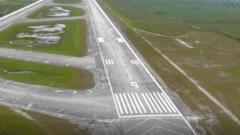A convoy of trucks laden with construction materials and portable toilets has begun arriving at a nearly deserted airport located in Florida's Everglades, a UNESCO World Heritage Site. While it may appear that preparations are underway for an exciting new attraction, the reality is far different: a migrant detention facility nicknamed "Alligator Alcatraz" is in the works.
The facility, situated within the swamps approximately 43 miles (70 km) from downtown Miami, is part of a larger agenda initiated by state lawmakers to bolster President Trump’s deportation efforts. Florida’s attorney general, James Uthmeier, shared insights on social media regarding the site, emphasizing that minimal resources would be essential for security—claiming, “If people get out, there’s not much waiting for them other than alligators and pythons.”
The site of the detention center is the Dade-Collier Training and Transition Airport, predominantly used for pilot training and surrounded by vast wetlands. As we approached the area, heavy mosquitoes accompanied the sweltering heat, and our progress was quickly impeded by a guard’s truck just beyond the site’s gates. The sounds emanating from a nearby canal raised questions about the presence of various wildlife, potentially including the alligators that are prevalent in the surrounding area.
Following a 2023 executive order from Republican Governor Ron DeSantis, this airstrip is set to become a facility capable of housing approximately 1,000 detainees, with operations expected to start by July or August. This project has quickly become emblematic of the immigration policies championed by the Trump administration. DeSantis has signaled that the creation of similar facilities might not cease with Alligator Alcatraz, hinting at a plan for development at Camp Blanding, a former U.S. Army base over 300 miles away.
Amidst a context where Immigration and Customs Enforcement (ICE) is reportedly holding 59,000 detainees—an increase of 140% above capacity—human rights advocates are deeply concerned about the implications of overcrowded detention centers. Betty Osceola, a member of the Miccosukee Native American community residing near the site, openly protested the construction, fearing that this facility would operate far beyond its proposed temporary duration. "I worry about the environmental impact," she expressed near a canal where an alligator swam, highlighting the dire situation facing both the ecosystem and potential detainees.
These sentiments have been echoed by various environmental groups and organizations such as the ACLU of Florida, which condemned the facility as a manifestation of a punitive immigration system more concerned with punishment than humane treatment. They pointed out that even existing ICE facilities demonstrate systemic shortcomings regarding medical care, legal access, and overall treatment.
In defense of the project, Uthmeier has described it as an "efficient" and "cost-effective" solution to immigration enforcement, asserting that the new detention center would ensure that detainees have “nowhere to go, nowhere to hide.” Homeland Security Secretary Kristi Noem corroborated this view, highlighting that the center would be funded by federal organizations like FEMA to expedite mass deportation efforts.
Despite the construction's pushback, it appears local leadership, including Miami-Dade County's Democratic Mayor Daniella Levine Cava, is also raising valid concerns focused on funding and alarming potential environmental consequences that could accompany the facility’s establishment. Current testimonies indicate that many undocumented individuals in South Florida live in fear of detainment and deportation, significantly affecting their daily lives.
As construction progresses on what some are calling "Alligator Alcatraz," the local community and organizations continue to grapple with the urgent environmental and human rights implications of this controversial initiative.





















